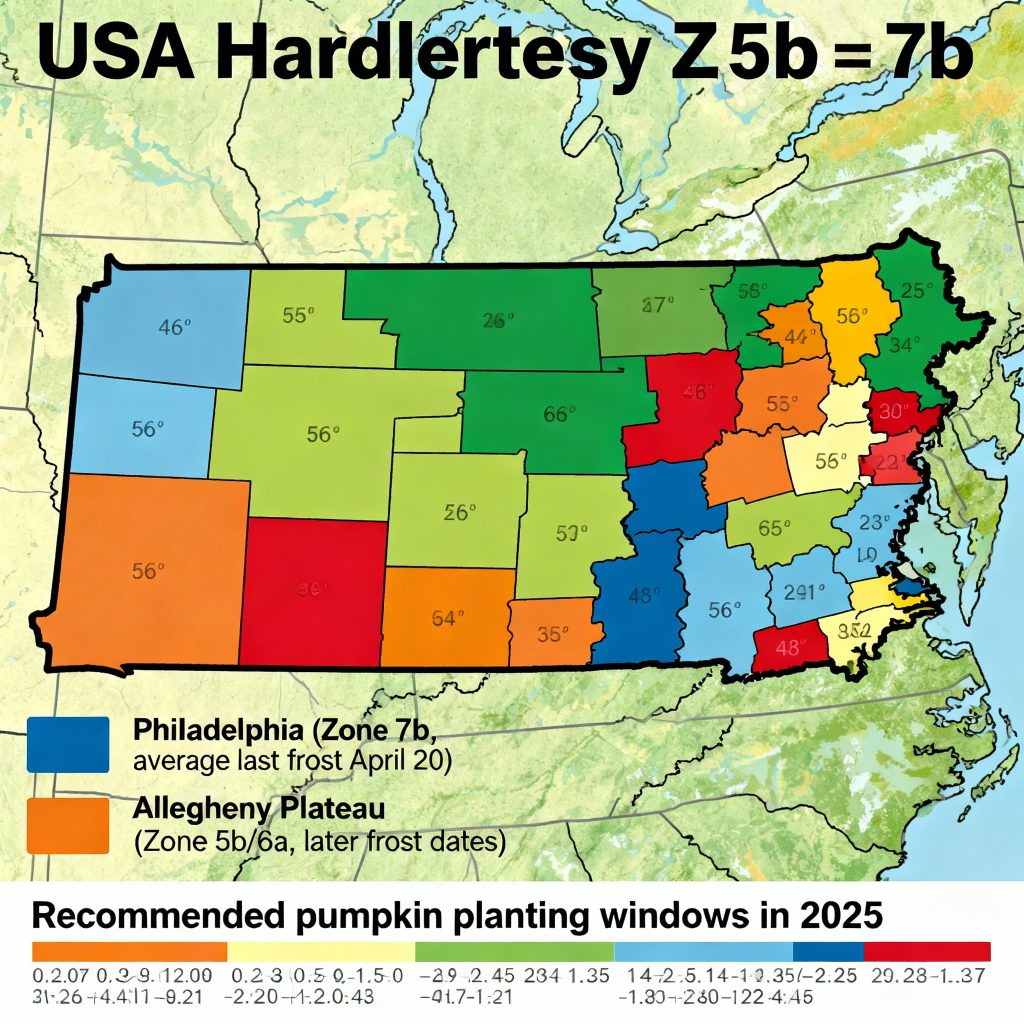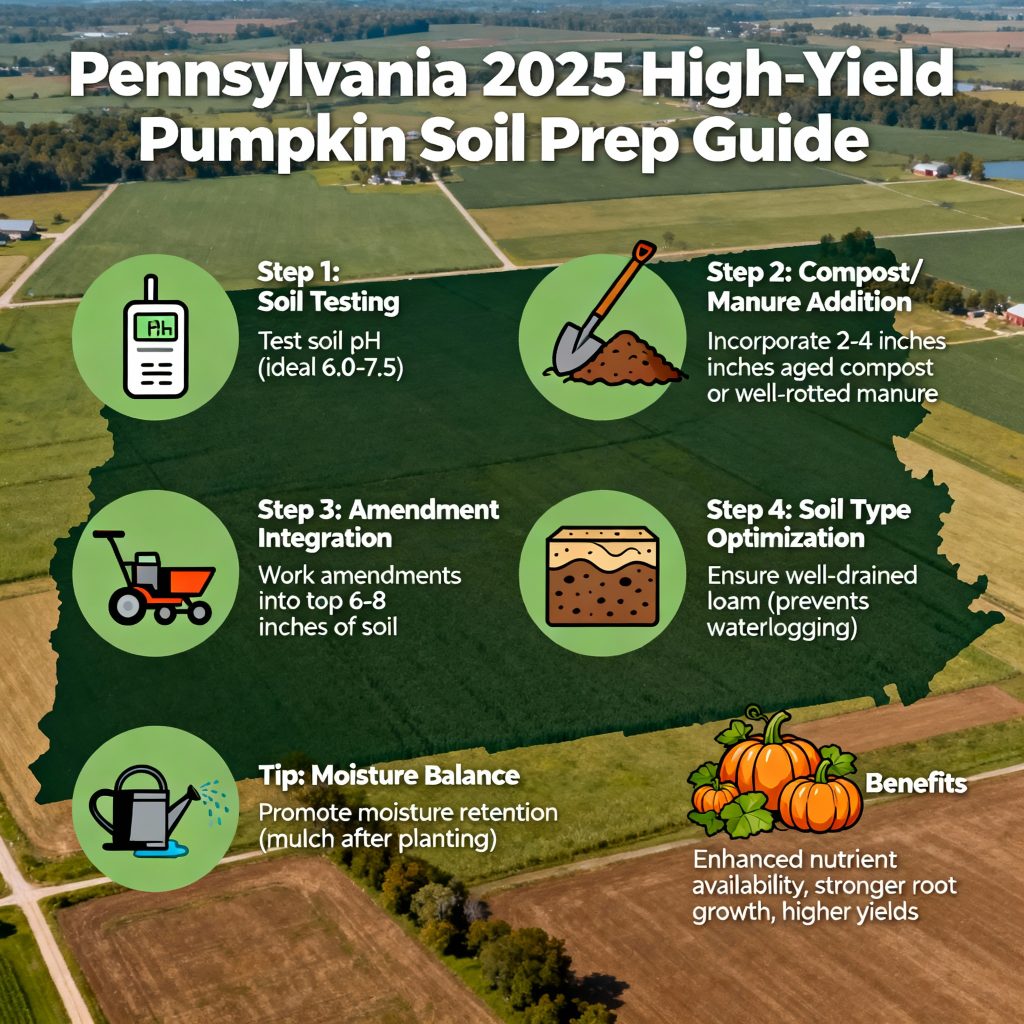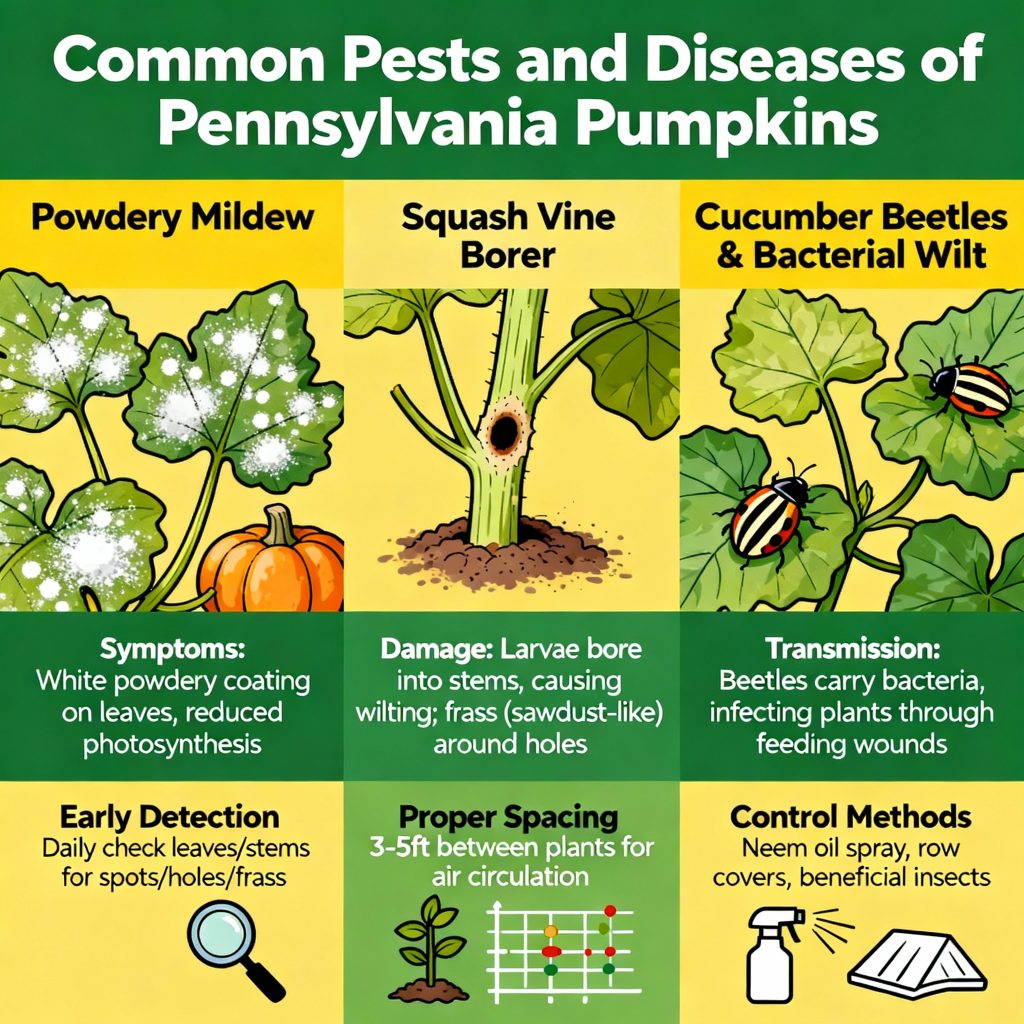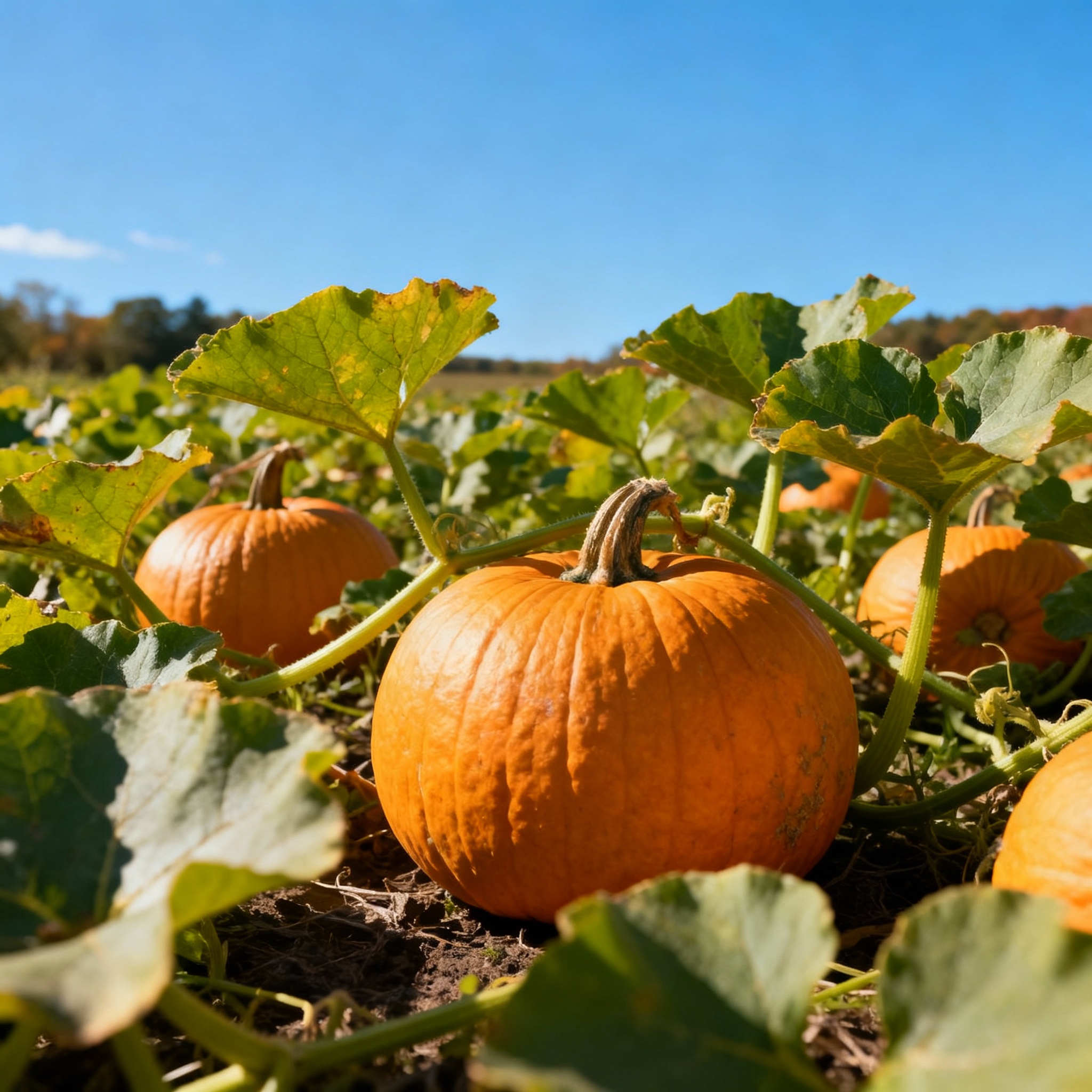For a successful harvest, Pennsylvania gardeners must align their pumpkin planting schedule with regional climate patterns and the specific cultivar they choose. The optimal sowing window is determined by two main factors: the soil temperature and the variety’s days to maturity. According to the Penn State Extension (2005), it is critical to wait until the soil has warmed to prevent seed rot and ensure strong germination.
Modern growers recommend using a soil thermometer to confirm the ground has consistently reached at least 60°F at a depth of three inches. This foundational step mitigates risk and promotes vigorous initial growth. Most pumpkin varieties require a minimum of 100 frost-free days to produce mature fruit, so timing is everything. For much of Pennsylvania, this means planting between late May and early July, but always factor in a 10-15 day buffer to account for unpredictable weather.

Decoding PA’s Hardiness Zones and Frost Dates
To ensure a successful pumpkin harvest, Pennsylvania growers must first identify their specific USDA Hardiness Zone. The state’s diverse geography spans zones 5b to 7b, creating distinct regional microclimates that directly impact the growing season length. These zones are critical for determining the last spring frost and the first fall frost, which define your planting and harvest timeline.
The climatic differences are significant. For example, Philadelphia (Zone 7b) has an average last spring frost date around April 20th. In contrast, higher elevations like the Allegheny Plateau (Zone 5b/6a) can experience damaging frosts until late May. This variability means a one-size-fits-all planting schedule for Pennsylvania is ineffective; timing must be localized.
It’s crucial to use your zone to calculate your safe planting window. The average last frost date for central Philadelphia is April 20th, but growers in outlying and higher-elevation areas should wait one to two weeks longer to sow seeds. This careful timing prevents frost from killing young, vulnerable seedlings and ensures a productive start.
Soil Preparation for a High-Yield Harvest
Achieving a high-yield pumpkin harvest in Pennsylvania starts well before you plant a single seed. As heavy feeders, pumpkins demand rich, well-structured soil to support their rapid growth. According to guidance from the Rutgers New Jersey Agricultural Experiment Station (2024), establishing the correct soil composition and nutrient balance from the outset is a non-negotiable step for a successful crop.
Your primary goal is to create a well-drained loam with a stable pH level. Pumpkins thrive in soil with a pH between 6.0 and 7.5, which ensures optimal nutrient uptake. To accomplish this, incorporate a generous soil amendment by working two to four inches of aged compost or well-rotted manure into the top six to eight inches of your garden bed. This practice enhances soil structure and provides a slow release of essential nutrients.
This preparation method directly addresses the needs of developing pumpkin root systems, preventing waterlogging while retaining necessary moisture. As noted by horticultural resources like the Alabama Cooperative Extension System (2025), building healthy soil is the most effective way to ensure vigorous plant development and prevent common growth issues later in the season.

Critical Soil Temperature and Nutrient Benchmarks
Beyond soil structure, two environmental benchmarks regulate successful pumpkin germination rate and early growth: soil temperature and nutrient availability. Sowing seeds into soil that is too cold is a primary cause of crop failure. For the 2025 season, modern growers emphasize using a soil thermometer to ensure the ground is ready for planting.
Pumpkin seeds germinate most effectively when soil temperatures are consistently between 65°F and 95°F. Planting in soil below 60°F significantly increases the risk of poor germination and makes seeds vulnerable to pests like the seed corn maggot. Before sowing, verify that the temperature at a three to four-inch depth remains stable for at least three consecutive days.
Once germinated, pumpkins require a steady supply of phosphorus and potassium to support root development and flowering. An imbalance in these key nutrients can lead to issues like blossom-end rot later in the season. Addressing these critical temperature and nutrient benchmarks from the start enhances plant resilience and establishes a strong foundation for a productive harvest.
Planting Methods: Direct Sowing vs. Indoor Starts
Pennsylvania gardeners can choose between two primary planting methods for the 2025 season: direct seeding into the garden or starting seeds indoors. While direct sowing is simpler, starting seeds indoors gives growers in regions with shorter seasons a critical head start. This technique helps ensure fruits mature before the first fall frost, a key consideration in northern PA counties.
Pumpkins are notoriously sensitive to root disturbance, which can cause significant transplant shock. To mitigate this, start seeds in three-inch biodegradable peat pots two to three weeks before your last frost date. This method allows you to plant the entire pot, minimizing stress on the root system. As the University of Maryland Extension (2023) advises, careful handling during this stage is paramount.
If you start seeds indoors, a process called hardening off is essential before moving them outside. This gradually acclimates the seedlings to outdoor conditions. However, be gentle; mishandling transplants can damage up to 50% of the root system, stunting growth for weeks as the plant recovers. Once the first true leaves, or cotyledons, have developed, you can confidently transplant.
Calculating Your Halloween Harvest Planting Date
Timing your planting for a perfect Halloween harvest is a straightforward calculation. To ensure you have mature, ready-to-carve Jack-o’-lanterns by mid-October, you must work backward from your desired harvest date. This simple formula removes the guesswork from your Halloween pumpkin harvest schedule and is essential for the 2025 season.
First, identify the “days to maturity” listed on your pumpkin seed packet. Next, choose your target harvest date—for example, October 10th. Subtract the days to maturity from this date, and then subtract an additional 10-day buffer to account for weather variations or a slower curing process. The resulting date is the latest you should plant your seeds.
For a Halloween harvest in most of Pennsylvania, this means seeds for typical carving pumpkins should be planted between late May and the end of June. Planting after July 4th significantly increases the risk that your pumpkins won’t reach the ideal maturity indicator—a hard rind and a deep, hollow sound when tapped—in time for carving.
Managing Common Pennsylvania Pumpkin Pests & Diseases
Even with perfect timing and soil, pumpkin crops in Pennsylvania are vulnerable to specific regional pests and diseases. Proactive management is key to protecting your harvest. Two of the most common threats are powdery mildew, a fungal disease, and the destructive squash vine borer, an insect pest.
You can identify a squash vine borer attack by looking for a small hole at the base of the stem accompanied by a sawdust-like substance known as frass. According to the National IPM Database (2000), early detection is crucial for managing this pest. Meanwhile, powdery mildew appears as white, talc-like spots on leaves, thriving in the humid Pennsylvania summers. This issue can be mitigated by ensuring proper air circulation through correct plant spacing, which reduces leaf moisture.
Another significant threat is the cucumber beetle, not just for the damage it causes by feeding, but because it can transmit bacterial wilt. This disease is particularly devastating, causing a healthy-looking plant to wilt and die within days. Regular scouting and applying an appropriate fungicide or pest control method at the first sign of trouble will safeguard your plants and ensure they reach maturity.

Vine Spacing, Watering, and Plant Management
Proper plant management is crucial for a healthy pumpkin patch, focusing on vine spacing and watering. Different pumpkin vine types—bush, semi-vine, and vining—have distinct spacing needs to ensure adequate airflow and sunlight exposure. Correct spacing is your first line of defense against common fungal diseases that thrive in dense, humid foliage.
Modern growers recommend specific spacing based on growth habit. Bush types require five to six feet between rows, while semi-vine types need six to eight feet. Aggressive, traditional vining varieties demand eight to twelve feet of space to spread out. This structured approach prevents overcrowding, which can otherwise stress plants and reduce fruit production.
Consistent watering is equally important. Pumpkins require at least one inch of water per week, especially during fruit development. Employing drip irrigation or watering deeply at the base of the plant maintains optimal soil moisture while keeping leaves dry. This technique is highly effective at preventing common issues like powdery mildew and blossom-end rot, ensuring your plants remain healthy and productive throughout the season.

Emily Hart is a U.S.-based horticulture specialist who reviews our plant care, propagation, and pest/disease guides for scientific accuracy. She emphasizes water-wise, pollinator-friendly practices and turns research into clear, seasonal steps any home gardener can follow. At Live Green Gardens, Emily ensures our how-tos reflect current best practices and safe methods.

